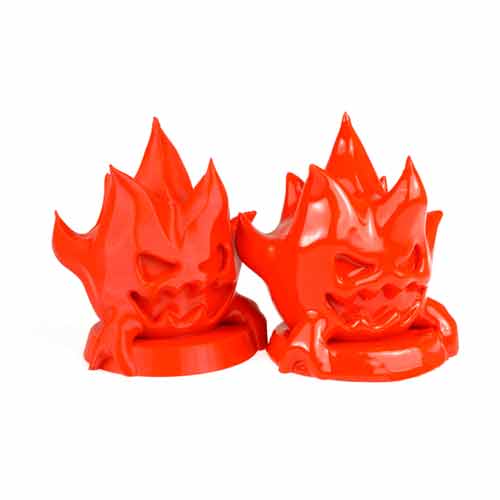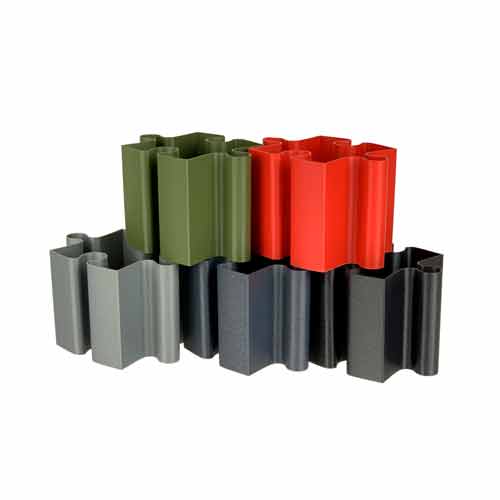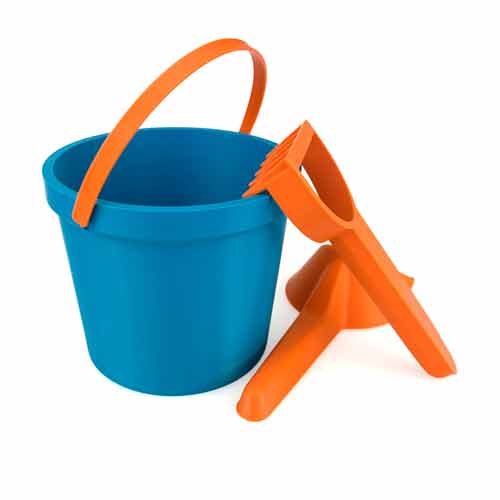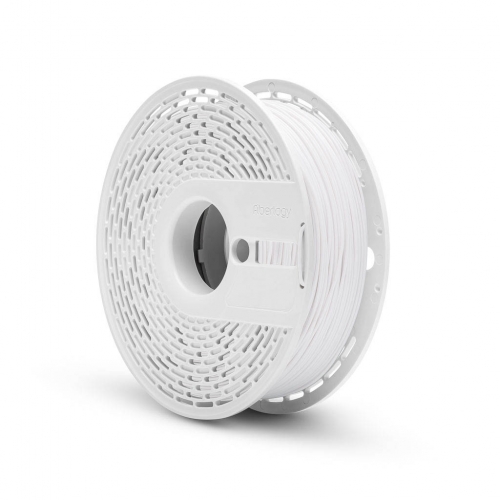
Fiberlogy ASA 1.75 mm White 750 g
ASA-WHITE-175-075
Brand: Fiberlogy, Poland
Fiberlogy ASA is a high-quality UV-resistant filament, an ideal ABS replacement for parts exposed to outdoor conditions. Provides strength, heat resistance, and durability.
- Strength: High | Stiffness: High
- Printing Difficulty: Medium
- Printing Temperature: 255°C - 270°C
- Bed Temperature: 90°C - 110°C
- High resistance to UV radiation and weather conditions
- Heat resistance up to 92°C
- Lower shrinkage and odor compared to ABS
- NET Weight: 750 g
Fiberlogy ASA Filament for 3D Printers Description
The 3D4U online store is pleased to present Fiberlogy ASA filament, 1.75 mm in diameter and weighing 750 g – the perfect choice for 3D printing objects intended for long-term use under weather exposure. This material is an excellent alternative to traditional ABS filament, offering improved resistance to ultraviolet radiation and easier printing.
ASA (Acrylonitrile Styrene Acrylate) is specifically designed for applications where durability and property retention in outdoor environments are crucial. It is resistant to UV rays, high temperatures (up to 92°C), and moisture, making it a popular choice in the automotive industry, for creating outdoor elements, sports equipment, and electronics enclosures.
A key advantage of ASA over ABS is significantly lower shrinkage during printing, which reduces the risk of model warping and layer cracking. This allows printing even without a fully enclosed chamber, although it is still recommended for achieving the best results and dimensional stability. Additionally, ASA emits noticeably less unpleasant odor during printing compared to ABS.
Finished products made from Fiberlogy ASA are easily post-processed: they can be sanded, painted, and glued using acetone. Chemical smoothing of the surface with acetone vapor is also possible to achieve a glossy finish.

3D4U is the official distributor of the Polish brand Fiberlogy products in Ukraine.
We offer a wide range of filament for 3D printing, provide professional consultations, and guarantee the authenticity of all Fiberlogy products.
Fiberlogy ASA Filament Properties
Fiberlogy ASA stands out among other engineering filaments due to its unique set of characteristics, making it indispensable for outdoor applications:
- High UV Resistance: Prints maintain their color and mechanical properties even under prolonged exposure to sunlight.
- Weather Resistance: The material is resistant to moisture, temperature fluctuations, and other atmospheric influences.
- Heat Resistance: Withstands temperatures up to 92°C (HDT @ 0.45 MPa), allowing its use for parts subject to heating.
- High Strength and Stiffness: Possesses good mechanical properties (tensile strength 45 MPa, tensile modulus 2200 MPa), comparable to ABS.
- Low Shrinkage (compared to ABS): Simplifies printing large objects and reduces the risk of warping.
- Low Odor during Printing: Makes the printing process more comfortable.
- Post-Processing Capability: Easily sanded, painted, glued, and smoothed with acetone.
- Durability: Ensures a long service life for printed items.
Note: Although ASA is less prone to shrinkage than ABS, using a 3D printer with an enclosed chamber or ensuring protection from drafts is still recommended for printing large or complex parts to prevent uneven cooling.
Fiberlogy ASA Print Examples
Evaluate the quality and printing capabilities using Fiberlogy ASA filament:

Calcifer models in ASA Red: left - as printed, right - after acetone smoothing

Complex shape parts made of Fiberlogy ASA in different colors

Outdoor toys (bucket, shovel) made of durable ASA
Applications of Fiberlogy ASA
Thanks to its resistance to external factors and good mechanical properties, Fiberlogy ASA finds application in various fields:
- Automotive Industry: Exterior parts (grilles, mirror housings, spoilers), interior elements, brackets, prototypes.
- Home and Garden Goods: Outdoor furniture, flower pots, decorative elements, housings for garden tools, outdoor toys.
- Sports and Tourism: Protective gear, action camera mounts, bicycle accessories, boat and kayak parts.
- Electronics and Instrumentation: Enclosures for sensors, controllers, outdoor surveillance cameras, and other equipment operating outdoors.
- Architectural Models: Creating durable models of buildings and structures resistant to fading.
- Functional Prototypes: Testing parts that will be operated under challenging conditions.
Fiberlogy ASA Printing Parameters
To achieve the best results when printing with Fiberlogy ASA filament, it is recommended to adhere to the following parameters. Please note that optimal settings may vary slightly depending on your specific 3D printer model and printing conditions.
| Parameter | Value |
|---|---|
| Nozzle Temperature | 255-270°C |
| Bed Temperature | 90-110°C |
| Enclosed Chamber | Recommended (but not strictly required) |
| Fan Speed | 0-25% (start at 0%, increase if needed for small parts or bridges) |
| Flow Rate | 90-100% |
| Printing Speed | < 100 mm/s (40-60 mm/s recommended for best quality) |
| Build Surface | Glass + adhesive (3DLAC, ABS juice), PEI sheet, Kapton tape |
| Retraction (direct drive) | Yes, 1-2 mm |
| Retraction (bowden) | Yes, 4-6 mm |
| Retraction Speed | 20-45 mm/s |
| Drying Conditions | 80°C / 4 hours (recommended before printing) |
Note: When printing without an enclosed chamber, avoid drafts and sudden temperature changes in the room. Ensure good first layer adhesion, as ASA still has a tendency to warp, although less than ABS. Using a brim or raft can help prevent the model from detaching from the build plate.
Fiberlogy ASA Technical Specifications
| Parameter | Value | Test Method |
|---|---|---|
| Diameter | 1.75 mm ± 0.02 mm | - |
| Average Roundness | + 0.01 mm | - |
| Specific Density | 1.07 g/cm³ | ISO 1183 |
| Tensile Strength @ Yield | 45 MPa | ISO 527 |
| Tensile Strength @ Break | 45 MPa | ISO 527 |
| Tensile Modulus | 2200 MPa | ISO 527 |
| Elongation @ Yield | 5% | ISO 527 |
| Elongation @ Break | 30% | ISO 527 |
| Flexural Strength | 80 MPa | ISO 178 |
| Flexural Modulus | 1900 MPa | ISO 178 |
| Izod Impact Strength (Notched @ 23°C) | 18 kJ/m² | ISO 180 |
| Heat Distortion Temperature (HDT) @ 0.45 MPa | 92°C | ISO 75 |
| Heat Distortion Temperature (HDT) @ 1.8 MPa | 86°C | ISO 75 |
| Vicat Softening Temperature | 100°C | ISO 306 |
| Glass Transition Temperature (Tg) | 105°C | DSC |
| Continuous Use Temperature (UL Yellow Card) | 50°C | UL 746 |
Tips for 3D Printing with Fiberlogy ASA
To get the most out of your ASA filament, follow these tips:
- Dry the Filament: ASA is hygroscopic (though less so than Nylon or PETG). Before printing, it's recommended to dry the spool at 80°C for 4 hours, especially if it has been stored without vacuum sealing. This prevents bubbles and improves surface quality.
- Control Temperature: A stable ambient temperature is important. Use an enclosed chamber or a printer enclosure to minimize temperature fluctuations and drafts.
- Bed Adhesion: Ensure reliable first layer adhesion. Heat the build plate to 90-110°C and use adhesives (3D printing adhesive, ABS juice) or special surfaces (PEI). A brim (5-10 mm) helps hold down the corners of the model.
- Part Cooling Fan: Start printing with the fan off (0%). If improved cooling is needed for bridges or small details, you can turn the fan on to 10-25%, but avoid excessive cooling which can cause layer splitting.
- Printing Speed: Don't rush. The optimal speed for ASA is typically in the 40-60 mm/s range. Too high a speed can impair layer bonding and mechanical properties.
- Acetone Smoothing: To achieve a smooth, glossy surface, you can use acetone vapor ("acetone bath"). Perform this procedure carefully in a well-ventilated area, as acetone is flammable and toxic.
- Ventilation: Although ASA smells less than ABS, it still emits styrene when melted. Print in a well-ventilated room.
Tip: If you are switching from printing PLA to ASA, remember that ASA requires significantly higher nozzle and bed temperatures, as well as more careful control of printing conditions to prevent warping and layer separation.
Comparing Fiberlogy ASA with Other Materials
Choosing the right material is key to a successful project. Here’s how Fiberlogy ASA compares to other popular filaments:
| Characteristic | Fiberlogy ASA | Fiberlogy ABS | Fiberlogy Easy PET-G |
|---|---|---|---|
| UV Resistance | Excellent | Low (yellows, becomes brittle) | Medium (better than ABS, worse than ASA) |
| Heat Resistance (HDT) | High (~92°C) | High (~90-100°C, depends on grade) | Medium (~70°C) |
| Mechanical Strength | High | High | High |
| Stiffness | High | High | High |
| Impact Resistance | Good | Good | Very High |
| Printing Difficulty | Medium (requires high temps, warp control) | High (high shrinkage, odor, needs enclosure) | Low/Medium (hygroscopic, potential stringing) |
| Shrinkage/Warping | Medium (less than ABS) | High | Very Low |
| Printing Odor | Low/Medium | Strong | Almost None |
| Chemical Resistance | Good | Good | Very High |
| Acetone Smoothing | Yes | Yes | No |
| Main Advantage | UV resistance, weather resistance | Strength, heat resistance, cost | Strength, ease of printing, chemical resistance |
Therefore, Fiberlogy ASA is the best choice if your print will be used outdoors or under direct sunlight. It combines the strength and heat resistance of ABS with improved UV stability and easier printing.
Why Choose Fiberlogy ASA
Choosing Fiberlogy ASA filament from 3D4U is an investment in the quality and durability of your 3D printing projects, especially those intended for outdoor use:
- Unmatched UV Resistance: Guarantees that your prints won't fade or lose strength under the sun.
- All-Weather Solution: Resistant to rain, moisture, and temperature fluctuations.
- Excellent ABS Alternative: Similar mechanical and thermal properties, but with better weather resistance and fewer printing issues.
- Strength and Reliability: Suitable for creating functional parts subject to stress.
- Aesthetics and Post-Processing: Ability to achieve a smooth surface (including with acetone) and paintability.
- Fiberlogy Quality Consistency: Precise filament diameter and stable material properties from spool to spool.
- Official Distributor: Buying from 3D4U ensures you get an original product and professional support.
Fiberlogy ASA is a reliable and versatile material for a wide range of tasks requiring resistance to external factors without compromising on strength.
How to Order Fiberlogy ASA
Ordering UV-resistant Fiberlogy ASA filament in Ukraine is easy through the 3D4U online store:
- Ensure the correct color and weight (750 g) are selected.
- Click the "Buy" or "Add to Cart" button.
- Go to the cart to review your order.
- Click "Proceed to Checkout" and fill in the necessary delivery details.
- Choose your preferred payment and delivery method.
- Confirm your order.
Our managers will promptly process your order and contact you to confirm the details. We offer fast delivery in Kyiv and across Ukraine. If you have any questions about choosing 3D printer filament or the ordering process, please contact us – we are always happy to help!
Start printing durable and weather-resistant items today with Fiberlogy ASA!
FAQ (Frequently Asked Questions) about Fiberlogy ASA
The main difference between ASA (Acrylonitrile Styrene Acrylate) and ABS (Acrylonitrile Butadiene Styrene) lies in the replacement of butadiene rubber with an acrylate elastomer. This gives ASA significantly higher resistance to UV radiation and weather conditions. ABS tends to yellow and become brittle under sun exposure, whereas ASA retains its properties and color much longer. Additionally, ASA typically has lower shrinkage during printing and emits a less pungent odor than ABS, making it slightly easier to work with.
Yes, it is recommended. ASA is a hygroscopic material, meaning it absorbs moisture from the air. Printing with moist filament can lead to defects: bubbles on the surface, stringing, poor layer adhesion, and reduced part strength. Even if the spool is new and was vacuum-sealed, preventive drying (80°C for 4 hours) is recommended before starting a print, especially for long prints or when high surface quality is required.
Strictly speaking, it's not mandatory, but it is highly recommended, especially for large parts. ASA has lower shrinkage than ABS, but it is still present. An enclosed chamber helps maintain a stable and high temperature around the model, preventing rapid and uneven cooling that causes warping and layer separation. If you don't have an enclosure, try to protect the printer from drafts as much as possible and print using a brim for better adhesion.
Yes, ASA is excellent for year-round outdoor use. Its key advantages are high resistance to UV radiation (doesn't fade or degrade in sunlight), moisture resistance, and the ability to withstand temperature fluctuations over a wide range (maintains properties from approximately -20°C to +80-90°C). This makes it ideal for garden tools, outdoor furniture, outdoor sensor housings, automotive parts, etc.
During printing, ASA emits Volatile Organic Compounds (VOCs), including styrene, although typically in smaller amounts than ABS. Therefore, good ventilation of the workspace is important. Use an exhaust fan or print in a well-ventilated room. It's not recommended to stay near the operating printer for extended periods without ventilation. Finished ASA parts are considered relatively safe for most applications, including those involving skin contact (e.g., enclosures). However, ASA is not certified as food-safe.
The most effective way to get a glossy surface on ASA prints is through acetone vapor smoothing ("acetone bath"). Acetone vapor dissolves the top layer of the filament, smoothing out layer lines and creating a shiny finish. This procedure must be done with great care:
- Use a glass or metal container with an airtight lid.
- Place acetone-soaked paper towels at the bottom (the part should not touch the liquid).
- Place the part on a platform (e.g., made of foil) inside the container.
- Seal the lid tightly and leave for a short time (from 10-20 minutes to an hour, depending on the desired effect and vapor concentration), checking the part's condition periodically.
- Perform the procedure in a well-ventilated area, away from ignition sources, and use protective gear (gloves, respirator).
- Allow the part to dry and air out completely after treatment.
Alternatively, some gloss can be achieved through careful sanding and polishing, but an acetone bath provides the most pronounced glossy effect.
| Manufacturer | Fiberlogy |
|---|---|
| Printing technology | FDM/FFF |
| Material type | ASA |
| Printing temperature, ℃ | 250-270 |
| Platform temperature, ℃ | 90-110 |
| Filament diameter, mm | 1.75 |
| Allowable deviation, mm | ±0.02 |
| Density, kg/m³ | 1070 |
| Color | White |
| Surface Finish / Effect | Standard |
| Filler / Additives | No Additives |
| Heat Resistance | High (85-110°C) |
| Specific Resistance | UV Resistant |
| Special Properties | Rigid |
| Spool Format | Standard Spool |
| Length, m | 292 |
| Weight, kg | 0.750 |
| Country | Poland |
| Condition | New |
No reviews for the product









